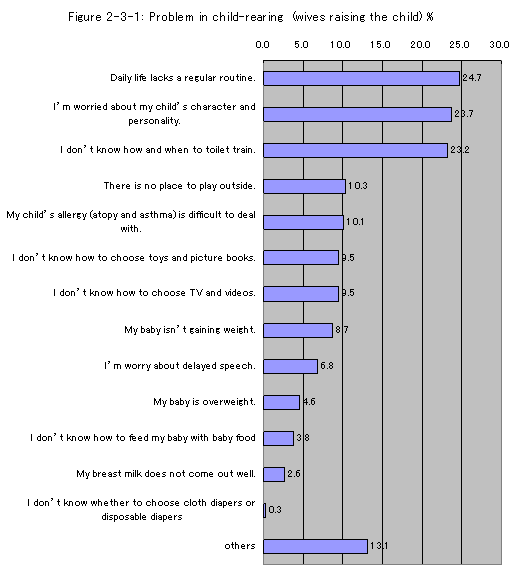- Part I. Research Outline / Introduction / 1. Actual conditions of pregnancy and delivery / 2. Attitude and awareness toward parenting (This article)
- Part II. 3. Child-rearing and the relationship of husband and wife / 4. Child-rearing environment
- Part III. 5. Balancing work and family during pregnancy and child-rearing / 6. QOL during pregnancy/child-caring period
Research Outline
Aim: To study the Quality of Life of first-time parents in their experience of conception, birth of the first child and childrearing, and the relation to the child-rearing environment and daily life conditions.
Method: Questionnaire distributed by mail
Period: November 2 to 17, 2006
| Sample: | Couples expecting their first child (wives during late pregnancy and husbands) Couples whose first child was 0 to 2 years old |
Number distributed: 16,000
Number collected: 5,773
Collection rate: 36.1%
4,479 sampled by this survey (couples having or expecting their first child)

Basic attribute of sample
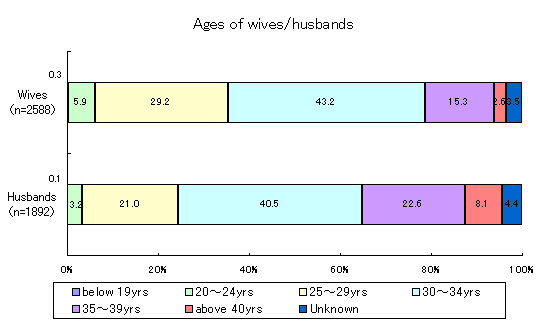

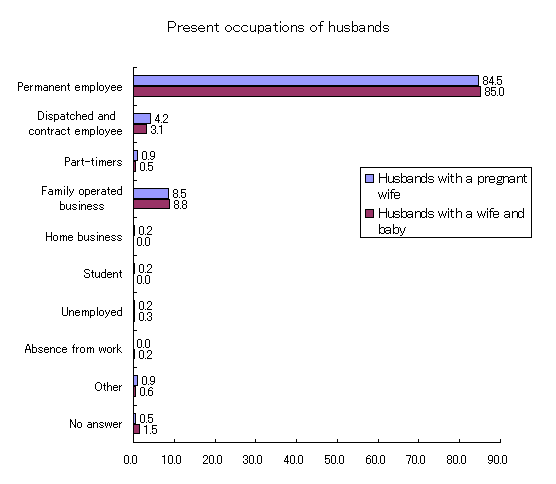
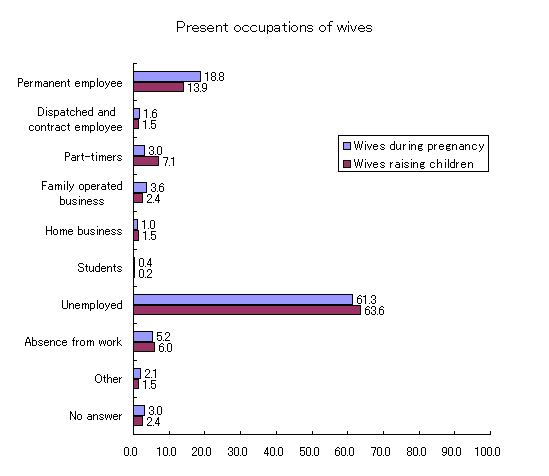
Introduction
Recently, changes in the social environment in Japan are accelerating due to the declining birthrate, a growing proportion of elderly people, a trend toward nuclear families, the social advancement of women, globalization, increasing use of IT, etc.. These changes have also influenced children's growth environment including the family situation and parent-child relationship. In order to investigate these changes Benesse Institute for Child Sciences and Parenting (BICSP) conducted a series of research surveys of "First-time Parenting."
A questionnaire survey was conducted in November 2006 and collected 4,479 responses from couples (wives during late pregnancy and husbands) and couples whose first child was 0 to 2 years old. The survey covers broad themes such as pregnancy, delivery, actual conditions of child-rearing, husband and wife relations, balancing work and family and so forth. A follow-up survey is also planned to focus on the process by which couples came to have their first child and became parents, and changes in their relationship. CRN will introduce the survey data in accordance with these six themes. The subjects of this article are "actual conditions of pregnancy and delivery" and "attitude and awareness toward parenting".
Junko Takaoka, Senior Researcher
Seiko Mochida, Researcher
Benesse Institute for the Child Sciences and Parenting
Actual conditions of pregnancy and delivery were surveyed, focusing on preparation and awareness of becoming a parent. Half of all wives conceived naturally, and 13.7% became pregnant after one or both of couples underwent treatment for fertility.
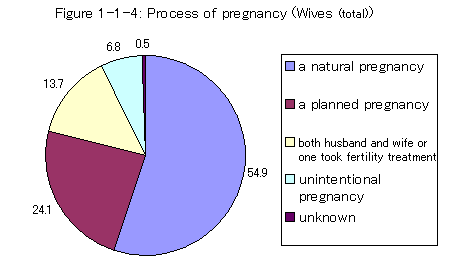
The rate of pregnancy with treatment rises as the wife's age increases, and reaches one out of four women who became pregnant after the age of 35 in the sample. The reasons they decided to give a birth are "I want to have my own child," "I want to have the child of the person I am in love with," "I thought it natural to have a child after getting marriage," which are followed by age-related reasons.
Table1-1-3| The reasons for deciding to give a birth | Wives (total) |
Husbands (total) |
|---|---|---|
| wanted to have our own child | 79.7% | 82.3% |
| wanted to have a child with the person I love | 59.8% | 52.8% |
| thought it natural to have a child after getting married | 54.7% | 59.1% |
| thought having a child could make everyday life more enriching and cheerful | 51.9% | 48.5% |
| felt it was the best timing to have a child thinking of my age | 44.9% | 39.1% |
| thought it might be the last chance to get pregnant thinking of my age | 23.5% | 15.1% |
| thought we had fully enjoyed our life as a couple | 19.5% | 9.9% |
| my partner wanted to have a child more than I did | 11.2% | 14.6% |
| did not expect or intend to become pregnant | 10.9% | 5.9% |
| thought having a child would bond our relationship | 8.8% | 9.9% |
| I had done everything I wanted | 8.2% | 2.5% |
| having a child is essential for the future of society | 7.0% | 13.3% |
| a child would be a support in old age | 5.2% | 5.9% |
| it was a good timing thinking of my career | 4.8% | 1.6% |
| our financial situation finally allowed us to have a child | 4.4% | 6.9% |
| had to have an heir | 3.0% | 6.0% |
| others | 3.6% | 1.2% |
Throughout the pregnancy, couples were positive and looked forward to the birth, but more than 70% of wives and husbands felt insecure about the process of pregnancy and concerned about pain during delivery.
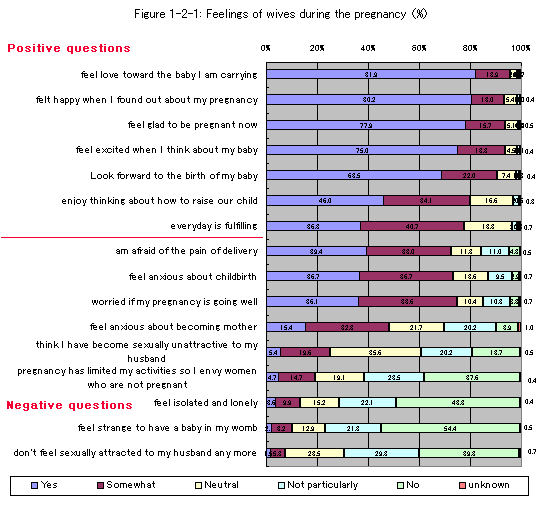
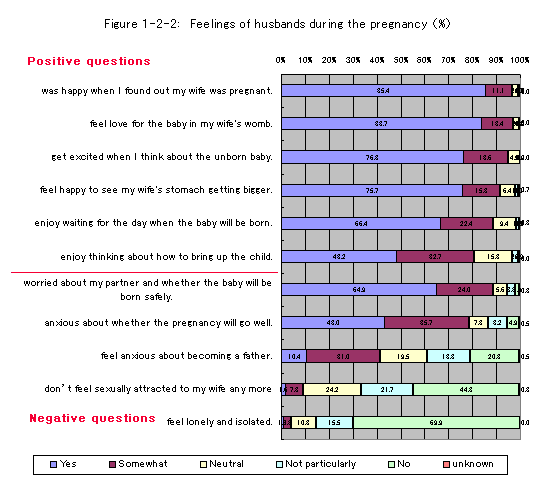
Approximately half of all wives and husbands (both expecting and raising a child) will become or became parents with no prior experience or contact with babies.
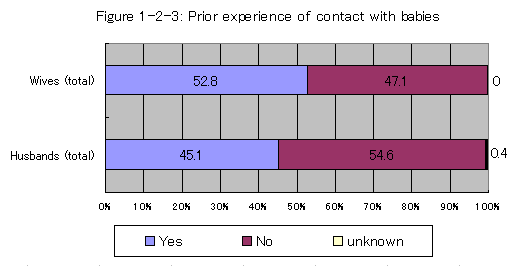
To compensate for this lack of experience, more than 80% of wives (raising their first child) participated in mothers' class or parenting class offered by local towns or hospitals. (Note 1: These were programs for preparing for pregnancy and delivery.) Half participated in parenting class with their husbands.
More than 95% of wives gave a birth in maternity hospitals of local doctors or at the department of obstetrics in general hospitals or university hospitals.
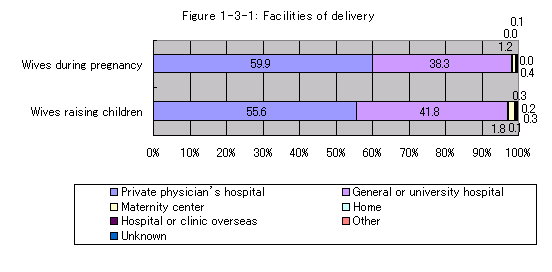
Only 2% delivered at maternity centers. Proximity to home or their parents' house was a main reason for choosing an institution. Recently, however, the number of obstetricians in Japan is decreasing. As a result, many pregnant women, especially in local areas, have to make a great effort to find a hospital where they can give birth. This problem is quite serious: 40% of mothers returned to their parents' home when giving birth. (It has been a Japanese practice for pregnant women to return for several weeks before and after the birth.) However, 25% of these women gave birth at a facility near their own home and returned to their parents' home only after giving birth. More than 50% of husbands were present at the birth.
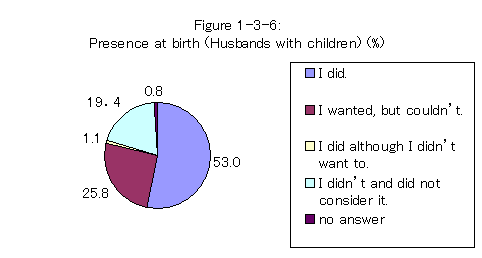
The highest percentage of both mothers and fathers (approximately 60%) answered that the ideal number of children is two, followed by three (25%). Among mothers or fathers who had an idea of the number and gender of children they wanted, the highest percentage answered that one girl and one boy would be ideal. (Seiko Mochida)
Chapter 2. Attitude and awareness toward parenting
How do mothers and fathers who have their first children feel about their parenting? Both mothers and fathers are very aware of instilling discipline and manners such as greetings. Many answered that they try to speak to their children in a kind and warm tone of voice.
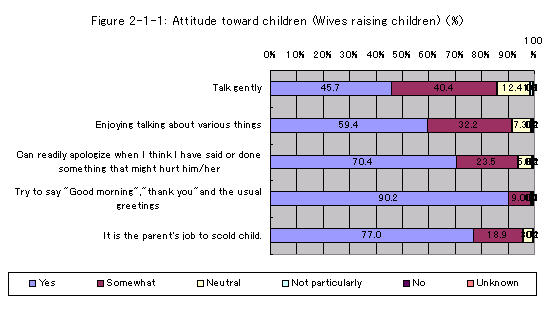
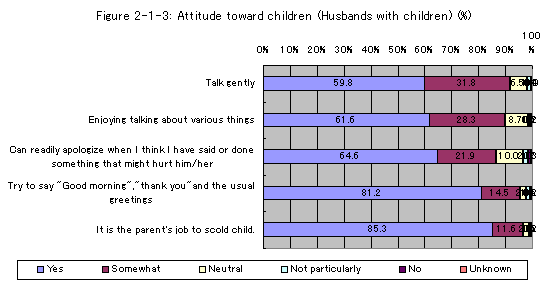
In general, they do not find parenting of their first child to be a great burden; on the contrary, they find it fulfilling and enjoyable. Although raising the first child is not an easy task, more then 50% of both mothers and fathers evaluate themselves as doing a good job as parents.
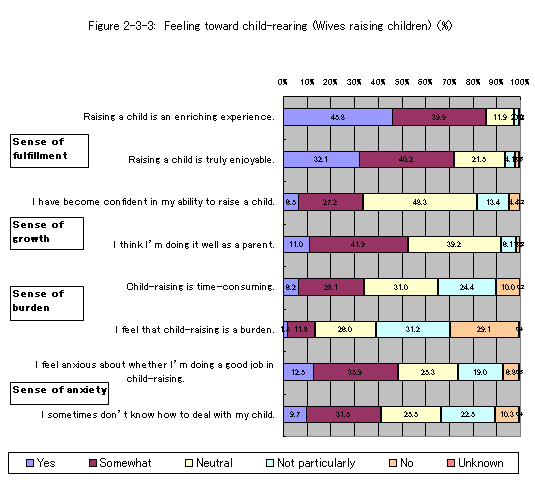
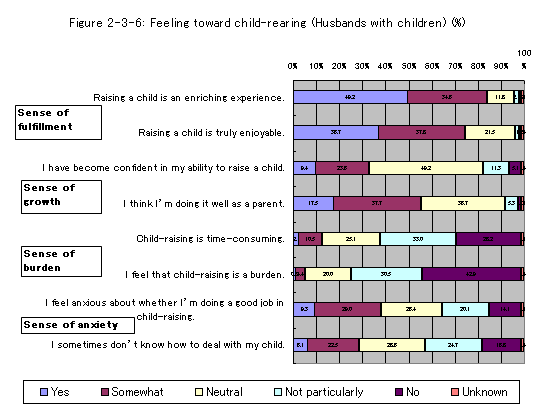
However, parents with very small child (0 to 2 years old) often feel stress. They were asked about 12 items considered to cause stress and whether they experienced stress as a result of each and the level of stress on a scale from one to five.
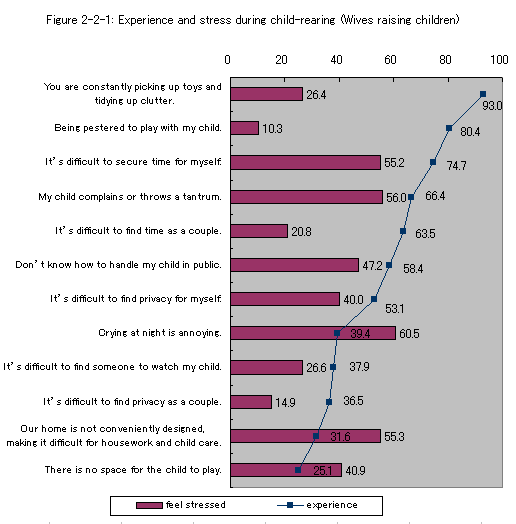
As a result of that, it turned out that more than 70% of mothers cannot have time for themselves and more than 50% of them feel stress as a result. In the relationship with their child, parents tend to feel stress when the child complains and throws a tantrum. However, they do not feel stress when the child wants them to play. Fathers also feel the highest stress when they cannot have time for themselves, but the number of such fathers is smaller than that of mothers. Regarding everyday affairs that are supposed to cause stress, fathers experience and feel less stress than mothers who do most of housework and parenting.
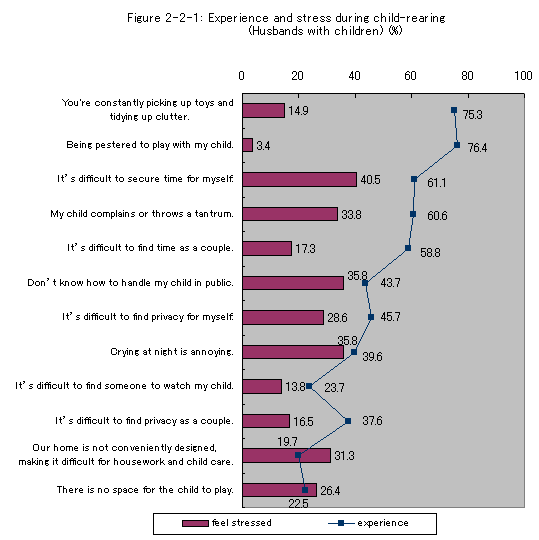
Mothers are asked about problems of 14 items related to child-rearing (figure 2-3-1). 24.7% of mothers have difficulty "getting their child to keep regular hours," 23.7% feel anxious about their child's character and personality and 23.2% feel insecure about not knowing when to toilet training and how to deal with it. Many mothers have worries that are related to their child's daily life habits and behavior. (Seiko Mochida)
